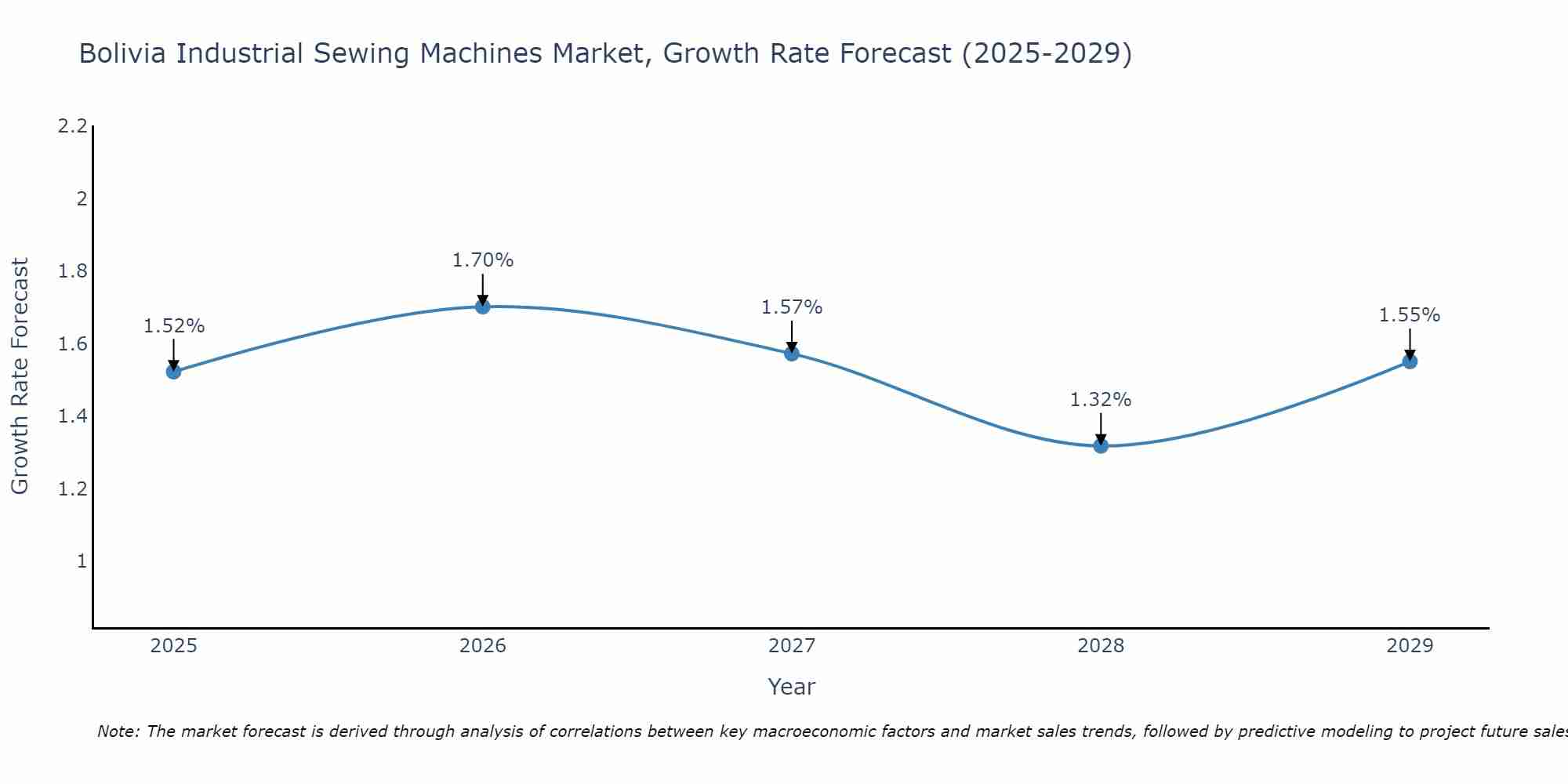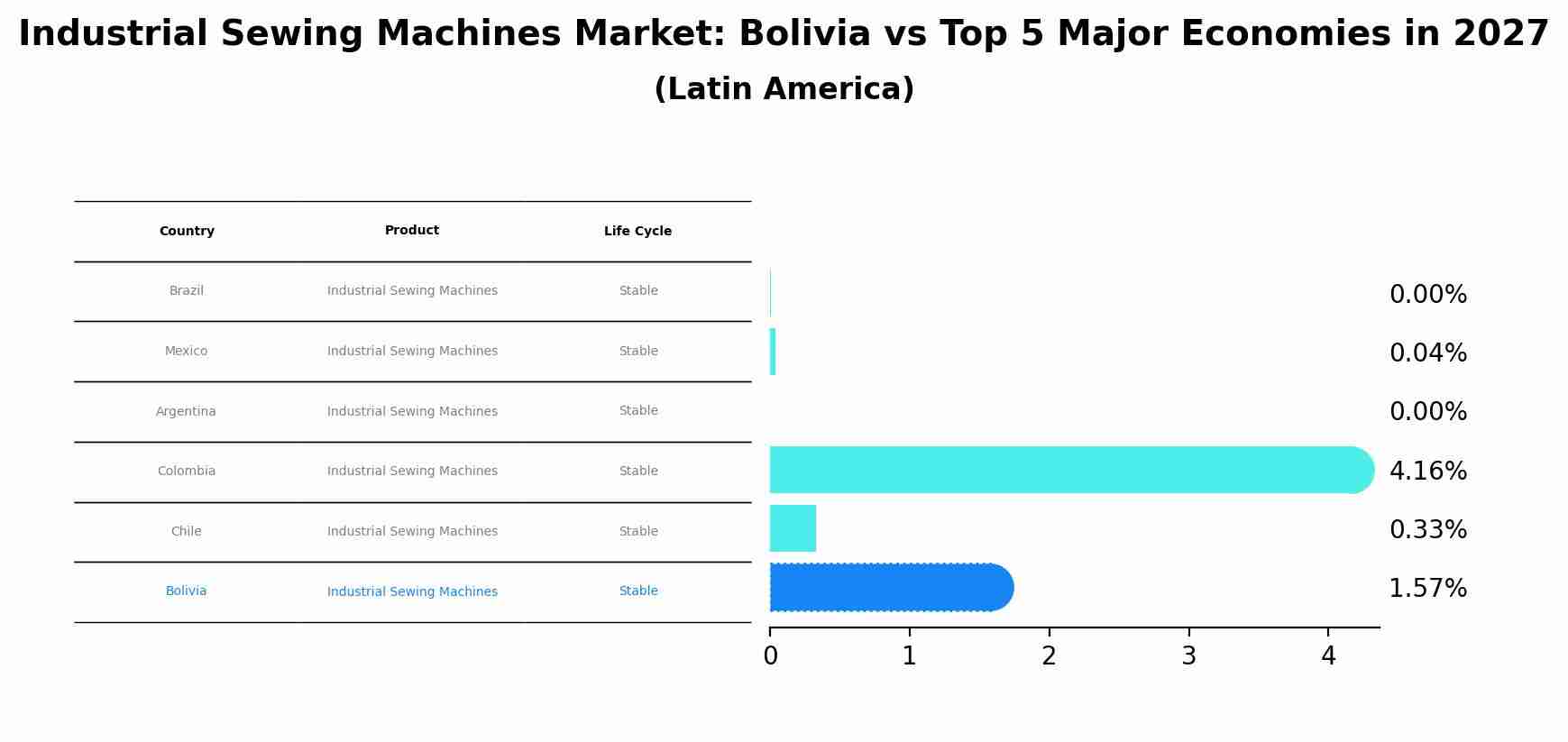Bolivia Industrial Sewing Machines Market (2025-2031) | Size, Analysis, Segmentation, Value, Outlook, Forecast, Revenue, Trends, Companies, Industry, Growth & Share
| Product Code: ETC4742787 | Publication Date: Nov 2023 | Updated Date: Sep 2025 | Product Type: Market Research Report | |
| Publisher: 6Wresearch | Author: Shubham Deep | No. of Pages: 60 | No. of Figures: 30 | No. of Tables: 5 |
Bolivia Industrial Sewing Machines Market Size Growth Rate
The Bolivia Industrial Sewing Machines Market is projected to witness mixed growth rate patterns during 2025 to 2029. Growth accelerates to 1.70% in 2026, following an initial rate of 1.52%, before easing to 1.55% at the end of the period.

Industrial Sewing Machines Market: Bolivia vs Top 5 Major Economies in 2027 (Latin America)
The Industrial Sewing Machines market in Bolivia is projected to grow at a stable growth rate of 1.57% by 2027, highlighting the country's increasing focus on advanced technologies within the Latin America region, where Brazil holds the dominant position, followed closely by Mexico, Argentina, Colombia and Chile, shaping overall regional demand.

Bolivia Industrial Sewing Machines Market Overview
Industrial sewing machines are used in the textile and apparel manufacturing industries. The market in Bolivia is expanding as these industries grow, driven by the demand for high-speed, durable, and reliable sewing solutions.
Drivers of the market
The industrial sewing machines market in Bolivia is supported by the growth of the textile and apparel industries, which require efficient and high-performance sewing solutions. Industrial sewing machines are essential for large-scale garment production, textile manufacturing, and other applications. As Bolivia`s textile sector expands and demand for high-quality garments increases, the market for industrial sewing machines grows. Additionally, advancements in sewing machine technology and a focus on improving productivity and product quality drive market growth.
Challenges of the market
The industrial sewing machines market in Bolivia encounters challenges such as high import costs and limited local manufacturing capabilities. There is also a need for investment in advanced sewing technologies and infrastructure to support the production and maintenance of industrial sewing machines. Additionally, market growth is impacted by limited awareness and technical expertise.
Government Policy of the market
In the industrial sewing machines market, Bolivias government policies emphasize quality, safety, and technological innovation. Regulations may set standards for machine performance, safety features, and maintenance. The government may provide support for companies investing in advanced sewing machine technologies and offer incentives for innovations that improve efficiency, precision, and durability in textile manufacturing.
Key Highlights of the Report:
- Bolivia Industrial Sewing Machines Market Outlook
- Market Size of Bolivia Industrial Sewing Machines Market, 2024
- Forecast of Bolivia Industrial Sewing Machines Market, 2031
- Historical Data and Forecast of Bolivia Industrial Sewing Machines Revenues & Volume for the Period 2021-2031
- Bolivia Industrial Sewing Machines Market Trend Evolution
- Bolivia Industrial Sewing Machines Market Drivers and Challenges
- Bolivia Industrial Sewing Machines Price Trends
- Bolivia Industrial Sewing Machines Porter`s Five Forces
- Bolivia Industrial Sewing Machines Industry Life Cycle
- Historical Data and Forecast of Bolivia Industrial Sewing Machines Market Revenues & Volume By Fabric Weight for the Period 2021-2031
- Historical Data and Forecast of Bolivia Industrial Sewing Machines Market Revenues & Volume By Lightweight for the Period 2021-2031
- Historical Data and Forecast of Bolivia Industrial Sewing Machines Market Revenues & Volume By Medium Weight for the Period 2021-2031
- Historical Data and Forecast of Bolivia Industrial Sewing Machines Market Revenues & Volume By Heavy Weight for the Period 2021-2031
- Historical Data and Forecast of Bolivia Industrial Sewing Machines Market Revenues & Volume By Extra-heavy Weight for the Period 2021-2031
- Historical Data and Forecast of Bolivia Industrial Sewing Machines Market Revenues & Volume By Bed Type for the Period 2021-2031
- Historical Data and Forecast of Bolivia Industrial Sewing Machines Market Revenues & Volume By Flat Bed for the Period 2021-2031
- Historical Data and Forecast of Bolivia Industrial Sewing Machines Market Revenues & Volume By Cylinder Bed for the Period 2021-2031
- Historical Data and Forecast of Bolivia Industrial Sewing Machines Market Revenues & Volume By Post Bed for the Period 2021-2031
- Historical Data and Forecast of Bolivia Industrial Sewing Machines Market Revenues & Volume By Application for the Period 2021-2031
- Historical Data and Forecast of Bolivia Industrial Sewing Machines Market Revenues & Volume By Apparel for the Period 2021-2031
- Historical Data and Forecast of Bolivia Industrial Sewing Machines Market Revenues & Volume By Non-apparel for the Period 2021-2031
- Bolivia Industrial Sewing Machines Import Export Trade Statistics
- Market Opportunity Assessment By Fabric Weight
- Market Opportunity Assessment By Bed Type
- Market Opportunity Assessment By Application
- Bolivia Industrial Sewing Machines Top Companies Market Share
- Bolivia Industrial Sewing Machines Competitive Benchmarking By Technical and Operational Parameters
- Bolivia Industrial Sewing Machines Company Profiles
- Bolivia Industrial Sewing Machines Key Strategic Recommendations
Frequently Asked Questions About the Market Study (FAQs):
1 Executive Summary |
2 Introduction |
2.1 Key Highlights of the Report |
2.2 Report Description |
2.3 Market Scope & Segmentation |
2.4 Research Methodology |
2.5 Assumptions |
3 Bolivia Industrial Sewing Machines Market Overview |
3.1 Bolivia Country Macro Economic Indicators |
3.2 Bolivia Industrial Sewing Machines Market Revenues & Volume, 2021 & 2031F |
3.3 Bolivia Industrial Sewing Machines Market - Industry Life Cycle |
3.4 Bolivia Industrial Sewing Machines Market - Porter's Five Forces |
3.5 Bolivia Industrial Sewing Machines Market Revenues & Volume Share, By Fabric Weight, 2021 & 2031F |
3.6 Bolivia Industrial Sewing Machines Market Revenues & Volume Share, By Bed Type, 2021 & 2031F |
3.7 Bolivia Industrial Sewing Machines Market Revenues & Volume Share, By Application, 2021 & 2031F |
4 Bolivia Industrial Sewing Machines Market Dynamics |
4.1 Impact Analysis |
4.2 Market Drivers |
4.2.1 Increasing demand for textile and garment manufacturing in Bolivia |
4.2.2 Growth of the fashion industry in the country |
4.2.3 Government initiatives to promote industrial development and manufacturing sector |
4.3 Market Restraints |
4.3.1 High import duties and taxes on industrial sewing machines |
4.3.2 Limited availability of skilled labor for operating industrial sewing machines |
4.3.3 Fluctuating raw material prices affecting manufacturing costs |
5 Bolivia Industrial Sewing Machines Market Trends |
6 Bolivia Industrial Sewing Machines Market Segmentations |
6.1 Bolivia Industrial Sewing Machines Market, By Fabric Weight |
6.1.1 Overview and Analysis |
6.1.2 Bolivia Industrial Sewing Machines Market Revenues & Volume, By Lightweight, 2021-2031F |
6.1.3 Bolivia Industrial Sewing Machines Market Revenues & Volume, By Medium Weight, 2021-2031F |
6.1.4 Bolivia Industrial Sewing Machines Market Revenues & Volume, By Heavy Weight, 2021-2031F |
6.1.5 Bolivia Industrial Sewing Machines Market Revenues & Volume, By Extra-heavy Weight, 2021-2031F |
6.2 Bolivia Industrial Sewing Machines Market, By Bed Type |
6.2.1 Overview and Analysis |
6.2.2 Bolivia Industrial Sewing Machines Market Revenues & Volume, By Flat Bed, 2021-2031F |
6.2.3 Bolivia Industrial Sewing Machines Market Revenues & Volume, By Cylinder Bed, 2021-2031F |
6.2.4 Bolivia Industrial Sewing Machines Market Revenues & Volume, By Post Bed, 2021-2031F |
6.3 Bolivia Industrial Sewing Machines Market, By Application |
6.3.1 Overview and Analysis |
6.3.2 Bolivia Industrial Sewing Machines Market Revenues & Volume, By Apparel, 2021-2031F |
6.3.3 Bolivia Industrial Sewing Machines Market Revenues & Volume, By Non-apparel, 2021-2031F |
7 Bolivia Industrial Sewing Machines Market Import-Export Trade Statistics |
7.1 Bolivia Industrial Sewing Machines Market Export to Major Countries |
7.2 Bolivia Industrial Sewing Machines Market Imports from Major Countries |
8 Bolivia Industrial Sewing Machines Market Key Performance Indicators |
8.1 Adoption rate of advanced sewing technologies in the textile industry |
8.2 Employment rate in the garment manufacturing sector |
8.3 Utilization rate of industrial sewing machines in factories |
9 Bolivia Industrial Sewing Machines Market - Opportunity Assessment |
9.1 Bolivia Industrial Sewing Machines Market Opportunity Assessment, By Fabric Weight, 2021 & 2031F |
9.2 Bolivia Industrial Sewing Machines Market Opportunity Assessment, By Bed Type, 2021 & 2031F |
9.3 Bolivia Industrial Sewing Machines Market Opportunity Assessment, By Application, 2021 & 2031F |
10 Bolivia Industrial Sewing Machines Market - Competitive Landscape |
10.1 Bolivia Industrial Sewing Machines Market Revenue Share, By Companies, 2024 |
10.2 Bolivia Industrial Sewing Machines Market Competitive Benchmarking, By Operating and Technical Parameters |
11 Company Profiles |
12 Recommendations | 13 Disclaimer |
- Single User License$ 1,995
- Department License$ 2,400
- Site License$ 3,120
- Global License$ 3,795
Search
Thought Leadership and Analyst Meet
Our Clients
Related Reports
- Afghanistan Apparel Market (2026-2032) | Growth, Outlook, Industry, Segmentation, Forecast, Size, Companies, Trends, Value, Share, Analysis & Revenue
- Canada Oil and Gas Market (2026-2032) | Share, Segmentation, Value, Industry, Trends, Forecast, Analysis, Size & Revenue, Growth, Competitive Landscape, Outlook, Companies
- Germany Breakfast Food Market (2026-2032) | Industry, Share, Growth, Size, Companies, Value, Analysis, Revenue, Trends, Forecast & Outlook
- Australia Briquette Market (2025-2031) | Growth, Size, Revenue, Forecast, Analysis, Trends, Value, Share, Industry & Companies
- Vietnam System Integrator Market (2025-2031) | Size, Companies, Analysis, Industry, Value, Forecast, Growth, Trends, Revenue & Share
- ASEAN and Thailand Brain Health Supplements Market (2025-2031) | Strategy, Consumer Insights, Analysis, Investment Trends, Opportunities, Growth, Size, Share, Industry, Revenue, Segments, Value, Segmentation, Supply, Forecast, Restraints, Outlook, Competition, Drivers, Trends, Demand, Pricing Analysis, Competitive, Strategic Insights, Companies, Challenges
- ASEAN Bearings Market (2025-2031) | Strategy, Consumer Insights, Analysis, Investment Trends, Opportunities, Growth, Size, Share, Industry, Revenue, Segments, Value, Segmentation, Supply, Forecast, Restraints, Outlook, Competition, Drivers, Trends, Demand, Pricing Analysis, Competitive, Strategic Insights, Companies, Challenges
- Europe Flooring Market (2025-2031) | Outlook, Share, Industry, Trends, Forecast, Companies, Revenue, Size, Analysis, Growth & Value
- Saudi Arabia Manlift Market (2025-2031) | Outlook, Size, Growth, Trends, Companies, Industry, Revenue, Value, Share, Forecast & Analysis
- Uganda Excavator, Crane, and Wheel Loaders Market (2025-2031) | Strategy, Consumer Insights, Analysis, Investment Trends, Opportunities, Growth, Size, Share, Industry, Revenue, Segments, Value, Segmentation, Supply, Forecast, Restraints, Outlook, Competition, Drivers, Trends, Demand, Pricing Analysis, Competitive, Strategic Insights, Companies, Challenges
Industry Events and Analyst Meet
Whitepaper
- Middle East & Africa Commercial Security Market Click here to view more.
- Middle East & Africa Fire Safety Systems & Equipment Market Click here to view more.
- GCC Drone Market Click here to view more.
- Middle East Lighting Fixture Market Click here to view more.
- GCC Physical & Perimeter Security Market Click here to view more.
6WResearch In News
- Doha a strategic location for EV manufacturing hub: IPA Qatar
- Demand for luxury TVs surging in the GCC, says Samsung
- Empowering Growth: The Thriving Journey of Bangladesh’s Cable Industry
- Demand for luxury TVs surging in the GCC, says Samsung
- Video call with a traditional healer? Once unthinkable, it’s now common in South Africa
- Intelligent Buildings To Smooth GCC’s Path To Net Zero


















